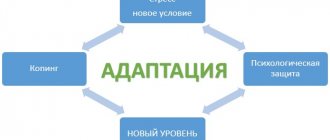Giftedness is a special level of development of personal abilities in psychology. Today, there is constant interest in the issue of giftedness, both in the field of science and in society. And famous people who are considered geniuses are not always truly brilliant from a scientific point of view. Even Alexander the Great, whom the average person would probably consider a genius, was unlikely to be one; he was just a successful student of the true genius Aristotle. And today this is often the result not of personal abilities, but of the help of behind-the-scenes forces - coaches, trainers, PR people, a whole team of professionals. Without it, a person cannot be so exceptionally successful in his business.
Giftedness is a phenomenon known even to children. They were asked what they knew about giftedness, and this is what they answered: “Giftedness is a talent when you are very good at something.” “Giftedness is when a person has a special gift, such as singing.” This understanding corresponds to the everyday concept of giftedness in adults. However, how does science reveal the concept of giftedness?
Giftedness in psychology is a property that allows its owner to achieve extraordinary results in activities. This can apply to one or several areas of life in which a person can be gifted at the same time. A bright, extremely rare talent, when a person differs so significantly from others in his performance results that he makes a breakthrough in an area of interest to him or even in several, is called genius.
What is giftedness
We often wonder why one person is considered gifted or even a genius, while another is not? Do you have to become a genius or can you be born one? How do diseases affect genius, and does nature really rest on the children of geniuses?
To what extent does giftedness depend on genes or on environment? According to the study of psychogeneticists using the example of analyzing the development of abilities of monozygotic twins, giftedness depends approximately half on genetics and half on the environment. And in the part that falls on environmental conditions, approximately half comes from the first two years of life, and of the remaining half, the family environment and society give equal parts. Nowadays, more and more attention is paid to intrauterine development. When an embryo grows, it is not so much the genes in their pure form that influence, but rather the interaction between the embryo and the environment; all kinds of stress and diseases can very powerfully affect the child’s abilities.
There is an opinion that “nature rests on the children of geniuses,” that they are much less or not at all talented compared to their parents. If we are dealing with genuine genius, this probably means that the corresponding 200-300 genes have come together in a very successful combination. If such a person has a child, then his genes are half mixed with the genes of his spouse, and such a successful combination will most likely no longer exist, but some of the genes will remain, so the child of a genius will most likely be gifted. But if we talk about the child of a simply gifted person, then the chance that his child will inherit giftedness is quite high.
There are cases where people with mental illness can be gifted in a particular area. This optimistic view is now being greatly reinforced by the media. Unfortunately, according to statistics, we can say the opposite - autism, schizophrenia and epilepsy are often accompanied by low IQ and do not contribute to giftedness. However, there are striking exceptions when a disease transforms the brain in such a way that this transformation benefits giftedness. For example, in epilepsy, there is a focus of increased arousal in the brain, which in severe cases leads to seizures. And if this focus throws its activation into the part of the brain that is responsible for a certain ability, then it may happen that the pathology will work as an extra source of energy for, for example, artistic or mathematical abilities. However, the difficulty here is that an epileptic seizure is akin to rebooting a computer, and after it the process is interrupted, which contributes to a greater extent not to mathematical, but to artistic abilities.
Also, giftedness in the case of illness, of course, is accompanied by successful environmental influences - parents make great efforts to educate and create the proper conditions for a special child.
Giftedness, talent, genius in psychology
The definition of potentially high abilities was given by Teplov, who designated them as qualitatively unique combinations of qualities that contribute to achieving success in a certain type of activity. The concept of “giftedness” in psychology is not equal to genius or talent. These definitions mean that a person is the highest level of intellectual or creative development of an individual. Potential capabilities refer to those that may not be visible during life and the intensity of their expression depends on whether they were involved in the development of the given at birth.
Signs of giftedness
Children's giftedness - how to identify it? We have already examined the genetic prerequisites for its formation and said that giftedness often coexists with high IQ, which suggests a cause-and-effect sequence between them. Methods for measuring IQ reveal the overall average indicator of the development of various abilities and rather measure adaptability, the ability to quickly navigate new information. There is a joke that IQ tests measure the ability to pass IQ tests, and there is some truth to this.
To identify a child’s giftedness, psychologists focus on the parameters “I want” and “I can,” that is, the presence of motivation for a certain activity, interest and pleasure from it, the manifestation of this motivation in activity, which are already visible results of abilities. Let's take a closer look.
The motivational side of giftedness as “I want” is defined in the fact that the child selectively reacts with great attention to individual stimuli. For example, when listening to the sound of music, he listens, freezes, and is able to listen to the sounds of music for a long time instead of playing games. Or he draws for a long time and in various ways and enjoys the process, and not the praise of adults for a beautiful drawing. This includes inspiration for building construction sets and unusual creative solutions in toy construction; children's enthusiasm for dancing and spontaneous expression of themselves in movement; interest in nature, the desire to observe animals or plants longer, care for and study them. The child is ready not only to be interested, but also wants to strive to bring his passion to the highest result, the peak of perfection, and receives personal satisfaction from this. All these aspirations are investments of energy resources in the chosen area and necessarily have their results associated with the next sign of giftedness - the aspect of activity.
The activity side of giftedness as “I can,” in addition to the fact that it is a continuation of the desire to engage in a certain activity and, as a result of this motivation, logically leads to high results, is also associated with the ability to quickly and successfully assimilate information, find new non-standard solutions, delve deeper into activities and set goals. the goals are more complex.
Giftedness in a certain area is manifested in the master’s own style of action, the personal style of the master, confirming his originality and the creative nature of his abilities, as opposed to simply memorized methods of action. The result of this individual style is a unique product of activity. This aspect also includes a deep understanding of the subject, systematic knowledge about it, the ability to study from any angle and move from simple to complex and vice versa. It is worth saying here that psychologists define giftedness as the ability to create new meanings. This is where the concept of giftedness intersects with creativity and creative thinking.
Types of giftedness
Are there separate types of giftedness? They can be distinguished by the degree of expression, form and breadth of manifestations, and types of activity.
As for the degree of expression, if you build human abilities along a certain scale, where zero is the absence of ability, then ordinary abilities follow, then giftedness and the highest values - genius. And the division between the norm and different levels of giftedness is only a continuous gradation, within which one can evaluate certain properties. And only by considering individual properties can we say that it is in the chosen parameter that he is especially gifted, which at the physical level corresponds to the high development of certain areas of the brain, associated, for example, with movements, vision, various types of memory, and logical thinking. When measuring IQ, psychologists consider specific abilities that form the overall indicator. In very rare cases, a person is gifted in all respects at once, such as Leonardo da Vinci, this is a one in a million case. But to be gifted in a specific parameter is, fortunately, a fairly common situation; at least half of people are endowed with individual abilities at the level of giftedness, and the task of each person is to determine his own giftedness and develop it.
According to the form, they distinguish between obvious, noticeable to everyone, and hidden, not yet manifested talent. With the latter, it is easy to make an erroneous conclusion about its absence, but giftedness can manifest itself at an unexpected moment in life, under changed external conditions or due to events in the inner mental life.
Based on the breadth of manifestation, a distinction is made between general and special talent. If the general applies to most types of human activity, then the special concerns only specific areas, the so-called narrow specialization.
Types of giftedness, defined in relation to the types of activities in which it is manifested, are practical, cognitive, communicative, artistic and spiritual.
Article “Methods of working with gifted children”
Methods of working with gifted children
The qualitative uniqueness and nature of the development of giftedness is always the result of a complex interaction between heredity (natural inclinations) and the social environment, mediated by the child’s activities (play, study, work). At the same time, the role of psychological mechanisms of self-development
personality, underlying the formation and implementation of individual talent.
One of the most controversial issues related to the problem of gifted children is the question of the frequency of manifestation of children's giftedness. There are two extreme points of view: “all children are gifted” and “gifted children are extremely rare.” These extremes are reconciled by the following position: potential giftedness in relation to various types of activity is inherent in many children, while actual giftedness is demonstrated by a small part of them.
A child’s giftedness is often manifested in the success of activities that were spontaneous, amateur in nature. For example, a child who is passionate about technology builds his own models at home, but his activity has nothing to do with school or specially organized extracurricular activities (in a technical club, section, studio). Another child enthusiastically composes poems or stories, but does not want to show them to the teacher. A child’s giftedness should be judged not only by his school activities, but also by his extracurricular activities, as well as by the forms of activity initiated by him.
In some cases, the reason for the disguised manifestations of giftedness is certain difficulties in the child’s development (for example, stuttering, increased anxiety, conflictual nature of communication, etc.).
When analyzing the characteristics of a child’s behavior, a teacher, psychologist and parents must make a kind of “admission” for insufficient knowledge of the child’s actual capabilities, while understanding that there are children whose talent they have not yet been able to see.
On the other hand, giftedness cannot always be distinguished from training (or more broadly, the degree of socialization), which is the result of more favorable living conditions for a given child. It is absolutely clear that, given equal abilities, a child from a family with a high socio-economic status will show higher achievements in certain types of activities compared to one for whom such conditions have not been created.
The giftedness of a particular child is largely a conditional characteristic. A child's most remarkable abilities are not a direct and sufficient indicator of his future achievements. When organizing practical work with children, you should not use the phrase “gifted child” in terms of stating (rigidly fixing) his status. The psychological drama of the situation is obvious when a child, accustomed to the fact that he is “gifted,” suddenly objectively loses the signs of his giftedness at the next stages of development. Based on this, in practical work with gifted children, instead of the concept of “gifted child,” the concept of “child with signs of giftedness” should be used.
Signs of giftedness
- those features of a gifted child that are manifested in his real activities and can be assessed at the level of observing the nature of his actions. Signs of obvious (manifested) giftedness are associated with a high level of performance. At the same time, a child’s giftedness should be judged in the unity of the categories “I want” and “I can.” Therefore, signs of giftedness cover two aspects of a gifted child’s behavior: instrumental and motivational.
Instrumental aspect
manifestations of a child’s giftedness can be characterized by the following features:
1. The presence of specific strategies for activity (quick mastery of activity and high success in its implementation; use and invention of new methods of activity in the context of searching for a solution to a given situation, etc.).
2. The formation of a qualitatively unique individual style of activity, expressed in the tendency to do everything in one’s own way and associated with the self-sufficient system of self-regulation inherent in a gifted child. Individualization of methods of activity is expressed in elements of uniqueness of the product itself.
3. A special type of learning ability. It can manifest itself both in high speed and ease of learning and in a slow pace of learning, but with a subsequent sharp change in the structure of knowledge, ideas and skills.
Motivational aspect
The behavior of a gifted child can be characterized by the following characteristics.
1. Increased selective sensitivity to certain aspects of objective reality (signs, sounds, colors, technical devices, plants, etc.) or to certain forms of one’s own activity (physical, cognitive, artistic and expressive, etc.), usually accompanied , experiencing a feeling of pleasure.
2. A pronounced interest in certain activities or areas of activity, extremely high passion for any subject, immersion in this or that matter. The presence of such an intense inclination to a certain type of activity results in amazing perseverance and hard work.
3. Increased cognitive need, which manifests itself in curiosity, as well as readiness, on one’s own initiative, to go beyond the initial requirements of the activity.
4. Preference for paradoxical, contradictory and uncertain information, rejection of standard, typical tasks and ready-made answers.
5. Highly critical of the results of one’s own work, a tendency to set extremely difficult goals, and a desire for perfection.
Among the criteria for identifying types of giftedness are the following.
1
.
According to the criterion “type of activity and the sphere of the psyche that supports it,”
the identification of types of giftedness is carried out within the framework of five types of activity, taking into account the inclusion of three mental spheres. The main types of activity include practical, theoretical (taking into account children's age, they talk about cognitive activity), artistic-aesthetic, communicative and spiritual-value. The spheres of the psyche are represented by the intellectual, emotional and motivational-volitional.
Widespread in the second half of the 20th century. consideration of “creative giftedness” as an independent type of giftedness is based on the initial contradiction: a person with high abilities may not be a creative person and, on the contrary, there are often cases when a less trained and even less capable person is such.
2
.
Based on the criterion “degree of development of giftedness,”
it is possible to differentiate between actual and potential giftedness.
Current talent
- a psychological characteristic of a child with already achieved indicators of mental development, which are manifested in a higher level of performance in a specific subject area compared to the age and social norm.
Talented children constitute a special category of actually gifted children. Talented child -
This is a child with such results of performing activities that meet the requirement of objective novelty and social significance. As a rule, a specific product of a talented child’s activity is assessed by an expert (a highly qualified specialist in a certain field of activity) as meeting, to one degree or another, the criteria of professional skill and creativity.
Potential giftedness —
psychological characteristics of a child who has only certain mental capabilities (potential) for high achievements in a particular type of activity, but cannot realize their capabilities at a given time due to their functional insufficiency. The development of this potential can be hampered by a number of reasons (difficult family circumstances, insufficient motivation, low level of self-regulation, lack of the necessary educational environment, etc.).
3
.
In accordance with the criterion “form of manifestation,”
a distinction is made between obvious and hidden talent.
Clearly gifted
manifests itself in the child’s activities quite clearly and clearly, including under unfavorable conditions. The child’s achievements are so obvious that his talent is beyond doubt.
Hidden talent
manifests itself in the child’s activities in a less pronounced, disguised form. As a result, there is a danger of erroneous conclusions about the lack of giftedness of such a child. He may be classified as “unpromising” and deprived of the help and support necessary to develop his abilities. Often no one sees the future beautiful swan in the “ugly duckling”. At the same time, there are numerous examples where precisely such “unpromising children” achieve the highest results.
The reasons for latent giftedness are largely related to the presence of special psychological barriers.
4.
Based on the criterion
“breadth of manifestations in various types of activities,”
one can distinguish general and special talent.
General talent
manifests itself in relation to various types of activities and acts as the basis of their productivity. The psychological core of general talent is mental abilities (or general cognitive abilities), around which the emotional, motivational and volitional qualities of the individual are built.
Special talent
reveals itself in specific types of activity and can be defined only in relation to certain areas of activity (music, painting, sports, etc.).
5
.
According to the criterion of “features of age-related development,”
early and late giftedness can be distinguished.
It is necessary to take into account that accelerated mental development and early detection of talents (the phenomenon of “age-related giftedness”) are not always associated with high achievements at an older age. At the same time, the absence of clear manifestations of giftedness in childhood does not mean a negative conclusion regarding the prospects for further mental development of the individual.
Identification of gifted children is a long-term process associated with a multidimensional analysis of the development of a particular child. principles for identifying gifted can be formulated :
► the comprehensive nature of assessing various aspects of the child’s behavior and activities;
► duration of identification (time-based observation of the behavior of a given child in different situations);
► analysis of the child’s behavior in those areas of activity that best correspond to his inclinations and interests (inclusion in specially organized object-based play activities, involvement in various forms of relevant object-based activities, etc.);
► the use of training methods, within the framework of which it is possible to organize certain developmental influences and remove psychological “barriers” typical for a given child;
► involvement of experts in the assessment of a gifted child: highly qualified specialists in the relevant subject area of activity. However, one should keep in mind the possible conservatism of the expert’s opinion, especially when assessing products of teenage and youth creativity;
► assessment of the signs of a child’s giftedness not only in relation to the current level of his mental development, but also taking into account the zone of proximal development (in particular, based on the organization of a specific educational environment with the building of an individual learning trajectory for a given child).
The experience of observing families of especially gifted children allows us to identify the following features that are of fundamental importance for the development of giftedness.
In families of especially gifted children, the high value of education is clearly visible. Increased, in comparison with ordinary families, attention to the child. Although such attention may subsequently become a brake on his mental autonomy, in a certain period it is precisely this that is one of the most important factors in the development of extraordinary abilities. Often the parents of gifted children are elderly people, for whom a child is the only meaning of life.
In many cases, it is the parents who begin to teach a gifted child, and often, although not always, one of them becomes a true teacher (mentor) of their child in a wide variety of activities for many years.
The fanatical desire of parents to develop his abilities has in some cases its negative sides. Thus, in these families there is a certain permissive attitude towards the development of a number of social and especially everyday skills in their child. Parents of gifted children pay special attention to their child’s school education, choosing textbooks or additional literature for him, consulting with the teacher on how best to study them. This circumstance sometimes has negative sides, when parents interfere in the educational process, in some cases even provoking a conflict with the administration and teachers.
Of great importance for understanding the personality characteristics of a gifted child and the nature of its development is the analysis of his relationships with peers and adults. Peers treat gifted children differently, depending on the nature of their giftedness and the degree of non-standardization of its manifestations. Due to their greater learning ability, including social and everyday skills, many gifted children are very popular among their peers. This especially applies to children with increased physical capabilities and, naturally, to child leaders.
The situation with special giftedness is much more complicated. In many cases, this giftedness is accompanied by unusual behavior and oddities, which causes bewilderment or ridicule among classmates. Sometimes the life of such a child in a group develops in the most dramatic way (the child is beaten, offensive nicknames are invented for him, humiliating pranks are played). To some extent, it is as a result of relationships with peers that children with such development are at risk.
True, in the latter case, much depends on the age of the children and on the value system adopted in a given children's community. In specialized schools, there is a much higher likelihood that the intellectual or academic abilities of a particularly gifted child will be appreciated and his relationships with peers will be more favorable.
Teachers have mixed attitudes towards gifted children. The relationship between teachers and children who show social giftedness depends on the direction of the interests of child leaders and on the nature of their involvement in school society (positive or negative). It is especially difficult for children with any type of giftedness, who have clearly expressed creative potential. Some features of their personality cause indignation among teachers, associated with their idea of these children as notorious individualists.
Although all gifted children are different - in temperament, interests, upbringing and, accordingly, in personality manifestations, there are nevertheless common personality traits that characterize the majority of gifted children and adolescents.
The most important characteristic of the personality of children with manifestations of giftedness is a special system of values,
that is, a system of personal priorities, the most important place in which is occupied by activities corresponding to the content of giftedness.
A significant proportion of gifted children are characterized by so-called perfectionism
(the desire to achieve excellence in performing activities). Sometimes a child spends hours redoing an already completed work (essay, drawing, model), achieving perfection known only to him.
has its own characteristics in gifted children ,
characterizing the child’s idea of his strengths and capabilities. It is quite natural that the self-esteem of these children and adolescents is very high, but sometimes, in especially emotional children, self-esteem is characterized by a certain inconsistency and instability.
An important feature of the personality of a child who shows signs of giftedness is the so-called internal locus of control, that is, taking responsibility for the results of his activities (and subsequently for everything that happens to him).
Many gifted children experience increased sensitivity and associated special emotional instability. Increased emotionality in some cases manifests itself in a tendency to violent emotions. In other cases, it is of a hidden, internal nature, revealing itself in excessive shyness in communication, difficulties falling asleep, and sometimes some psychosomatic diseases.
One of the main personal characteristics of children and adolescents with increased creative potential is independence (autonomy, the inability to act, think and act like the majority). Children with creative potential, no matter in what area of activity their talent is manifested, in comparison with other people, are little oriented toward the general opinion and established rules. Gifted children of this type behave less predictably than others would like, which sometimes leads to conflicts. Basically, apparently, we can talk about a certain non-conformity of brightly gifted, creative children. This is perhaps one of the reasons for their non-compliance with social norms and the requirements of the team.











